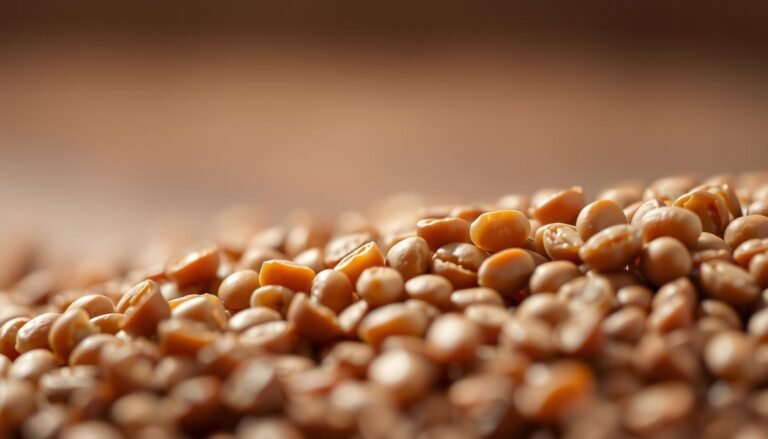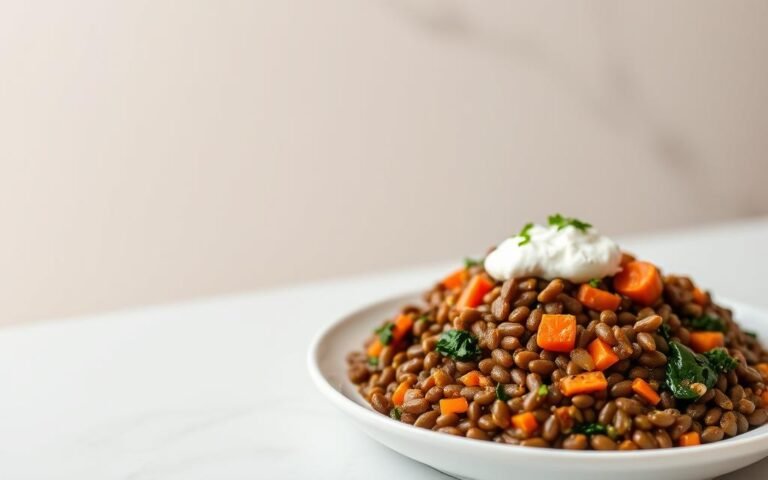Incorporating lentils into your daily meals can be a simple yet effective way to enhance your anti-inflammatory diet. Lentils are rich in nutrients and have been shown to possess anti-inflammatory properties, making them an excellent addition to your dietary plan.
By including lentils in your diet, you can potentially reduce inflammation and improve overall health. This article will provide a comprehensive daily plan to help you get started.
Key Takeaways
- Understand the benefits of lentils in reducing inflammation.
- Learn how to incorporate lentils into your daily meals.
- Get a comprehensive daily plan to follow.
- Discover simple and delicious lentil-based recipes.
- Improve your overall health with an anti-inflammatory diet.
Understanding the Anti-Inflammatory Diet
Understanding the anti-inflammatory diet is essential for those looking to improve their overall health. Chronic inflammation is linked to various health conditions, and diet plays a crucial role in managing it.
What Causes Inflammation in the Body
Inflammation can be triggered by a variety of factors, including poor diet, stress, and environmental toxins. Consuming high amounts of processed foods and sugars can lead to chronic inflammation.
Key Principles of Anti-Inflammatory Eating
An anti-inflammatory diet emphasizes whole, nutrient-dense foods like fruits, vegetables, and whole grains. It also includes inflammation-fighting foods such as fatty fish, nuts, and seeds.
| Food Group | Examples | Benefits |
|---|---|---|
| Fruits | Berries, citrus fruits | Rich in antioxidants |
| Vegetables | Leafy greens, broccoli | High in vitamins and minerals |
| Protein Sources | Fatty fish, lentils | Rich in omega-3 fatty acids and fiber |
By incorporating these healthy eating tips into your daily routine, you can potentially reduce inflammation and improve your overall well-being.
The Power of Lentils in an Anti-Inflammatory Diet
Lentils are a nutritional powerhouse that can significantly enhance an anti-inflammatory diet. They offer a rich source of essential nutrients, making them an ideal component for reducing inflammation and promoting overall health.
Nutritional Profile of Lentils
Lentils are packed with fiber, protein, and various minerals, making them a nutritious addition to any meal. They are an excellent source of:
- Plant-based protein: Essential for muscle repair and overall health.
- Dietary fiber: Helps in maintaining healthy digestion and satiety.
- Iron: Crucial for healthy red blood cells.
- Folate: Important for cell division and growth.
Anti-Inflammatory Properties of Lentils
The anti-inflammatory properties of lentils are attributed to their rich nutritional profile. The high fiber content in lentils helps in reducing inflammation by promoting a healthy gut microbiome. Additionally, lentils contain polyphenols, which are known for their antioxidant properties, further contributing to their anti-inflammatory effects.
As noted by a study, “Diets rich in fiber and polyphenols can significantly reduce inflammatory markers in the body.” Incorporating lentils into your diet can be a simple yet effective way to harness these benefits.
Types of Lentils and Their Unique Benefits
Exploring the various types of lentils reveals their diverse nutritional benefits and culinary applications. Lentils are a staple in many cuisines, particularly in anti-inflammatory diets, due to their high nutritional value and versatility.
Brown and Green Lentils
Brown and green lentils are among the most commonly consumed types. They hold their shape well after cooking, making them ideal for salads and stews. Rich in fiber and protein, they support digestive health and provide a feeling of fullness.
Red and Yellow Lentils
Red and yellow lentils are known for their bright color and softer texture. They cook quickly and are often used in soups and purees. These lentils are high in antioxidants and support heart health.
Black Lentils
Black lentils, also known as beluga lentils, have a distinctive shiny black appearance. They retain their texture after cooking and are rich in anthocyanins, which have anti-inflammatory properties.
French Lentils
French lentils, or Puy lentils, are known for their dark blue-green color and peppery flavor. They are particularly high in fiber and are often used in gourmet dishes due to their unique taste and texture.
Each type of lentil offers unique benefits, making them a valuable addition to an anti-inflammatory diet. By incorporating a variety of lentils into your meals, you can maximize their nutritional benefits.
Preparing Lentils for Maximum Anti-Inflammatory Benefits
To maximize the anti-inflammatory benefits of lentils, proper preparation is key. Lentils are a rich source of nutrients and antioxidants, but their nutritional value can be enhanced or diminished based on how they are prepared.
Soaking and Sprouting Methods
Soaking and sprouting lentils can significantly increase their nutritional value. Soaking helps to break down some of the anti-nutrients like phytic acid, making the lentils more digestible. Sprouting, on the other hand, activates enzymes that boost the bioavailability of nutrients. To sprout lentils, start by soaking them in water for 8-12 hours, then drain and rinse them. Allow the lentils to sit in a cool, dark place for 1-3 days, rinsing them daily, until they begin to sprout.
Cooking Techniques to Preserve Nutrients
Cooking lentils using the right techniques can help preserve their nutrients. Steaming is an excellent method as it uses minimal water and heat, thus retaining more of the lentils’ natural antioxidants and fiber. Another technique is to cook lentils until they are tender but still retain some firmness, avoiding overcooking which can lead to a loss of nutrients. Pressure cooking is also a good option as it reduces cooking time and helps preserve nutrients.
| Cooking Method | Nutrient Retention | Cooking Time |
|---|---|---|
| Steaming | High | 20-25 minutes |
| Boiling | Medium | 25-30 minutes |
| Pressure Cooking | High | 5-10 minutes |

A 7-Day Plan for Including Lentils in Anti-Inflammatory Diet
To reap the anti-inflammatory benefits of lentils, it’s essential to have a clear plan, which is why we’ve put together a 7-day guide to help you incorporate these nutritious legumes into your diet. A well-structured meal plan can make all the difference in ensuring you’re getting the most out of lentils.
Daily Lentil Consumption Guidelines
For an anti-inflammatory diet, aiming for about 1 cup of cooked lentils per day is a good starting point. This can be distributed across meals, such as adding lentils to your breakfast oatmeal, having a lentil salad for lunch, and cooking lentil soup for dinner. Including a variety of colored lentils can provide a broad spectrum of nutrients.
Sample Week-Long Meal Plan
Here’s a sample 7-day meal plan to help you get started on your lentil-rich anti-inflammatory diet:
| Day | Breakfast | Lunch | Dinner |
|---|---|---|---|
| Monday | Lentil Oatmeal | Lentil and Avocado Salad | Lentil Soup |
| Tuesday | Green Smoothie with Lentil Powder | Quinoa and Lentil Bowl | Indian-Style Lentil Curry |
| Wednesday | Lentil and Spinach Scramble | Lentil Salad Wrap | Ethiopian Lentil Stew |
| Thursday | Breakfast Burrito with Lentils | Lentil and Vegetable Stew | Lentil and Mushroom Bolognese |
| Friday | Lentil Pancakes | Lentil and Arugula Salad | Spicy Red Lentil Curry |
| Saturday | Lentil and Banana Smoothie | Lentil and Chicken Salad | Lentil and Vegetable Kebabs |
| Sunday | Lentil Omelette | Lentil and Quinoa Salad | French Lentil Salad |
For more detailed meal plans and variations, you can refer to resources like Eating Well’s 7-Day Anti-Inflammatory Diet Meal.
Shopping List and Prep Tips
To make the most of your 7-day meal plan, it’s helpful to have a well-stocked pantry and fridge. Your shopping list should include a variety of lentils (green, red, yellow, and black), along with anti-inflammatory spices like turmeric and ginger. Prepping lentils in advance by soaking or cooking them can save time during the week.
Breakfast Ideas with Lentils
Discover how lentils can transform your breakfast into a nutritious and filling meal. Incorporating lentils into your morning routine can provide a boost of energy and support an anti-inflammatory diet.
Quick Lentil Breakfast Bowls
Start your day with a quick and easy lentil breakfast bowl. Simply cook lentils with some vegetables and spices, then top with your favorite ingredients like avocado, eggs, or nuts. Here are some ideas:
- Lentil and Avocado Bowl: Mix cooked lentils with diced avocado, cherry tomatoes, and a squeeze of lemon juice.
- Spicy Lentil Breakfast: Combine cooked lentils with diced jalapeños, cilantro, and a fried egg.
Lentil Smoothies and Breakfast Bars
Lentils can also be blended into smoothies or used in homemade breakfast bars. Cooked lentils can be frozen for later use in these recipes.
- Lentil Banana Smoothie: Blend cooked lentils with banana, spinach, and almond milk.
- Lentil Oat Breakfast Bars: Mix cooked lentils with oats, nuts, and dried fruits, then bake into bars.
Weekend Lentil Breakfast Recipes
For a more leisurely breakfast, try these lentil recipes perfect for the weekend:
- Lentil and Mushroom Crepes: Fill crepes with a mixture of cooked lentils, sautéed mushrooms, and cheese.
- Lentil Breakfast Casserole: Layer cooked lentils, vegetables, and eggs in a baking dish for a hearty breakfast.
These lentil breakfast ideas offer a variety of healthy breakfast recipes to start your day off right.
Lunch Recipes Featuring Lentils
Lentils are a versatile ingredient that can be used in a variety of delicious and healthy lunch recipes. They are rich in nutrients and can be easily incorporated into soups, salads, wraps, and more, making them an ideal choice for a quick and anti-inflammatory lunch.
Anti-Inflammatory Lentil Soups and Stews
Lentil soups and stews are comforting and nutritious options for lunch. They can be made in large batches and refrigerated or frozen for later use. Adding anti-inflammatory spices like turmeric and ginger can enhance their health benefits.
Lentil Salads for Work Lunches
Lentil salads are a great option for work lunches as they are easy to prepare, pack, and transport. Mixing lentils with vegetables like spinach, tomatoes, and cucumbers, and dressing with olive oil and lemon juice, creates a refreshing and healthy meal.
Lentil Wraps and Sandwiches
Lentil wraps and sandwiches are convenient and can be customized with various fillings. Using whole grain wraps and adding vegetables like lettuce, carrots, and cucumbers, along with hummus or avocado spread, makes for a satisfying and anti-inflammatory lunch.
| Recipe | Main Ingredients | Prep Time |
|---|---|---|
| Lentil Soup | Lentils, vegetables, broth | 30 minutes |
| Lentil Salad | Lentils, spinach, tomatoes, olive oil | 20 minutes |
| Lentil Wrap | Lentils, whole grain wrap, hummus, vegetables | 15 minutes |
Dinner Options with Lentils as the Star
For a delicious and anti-inflammatory dinner, consider making lentils the star. Lentils are not only nutritious but also incredibly versatile, allowing you to create a variety of dishes that cater to different tastes and dietary needs.

Lentil Curries and Dahls
Lentil curries and dahls are popular dinner options that are both flavorful and nutritious. These dishes are rich in spices and can be made with a variety of lentils, such as red, yellow, or green lentils. They are perfect for a quick weeknight dinner and can be served with rice or naan bread.
Lentil Burgers and Loaves
For a twist on traditional dinner, consider making lentil burgers or loaves. These are great alternatives to meat-based dishes and can be seasoned with a variety of herbs and spices. Lentil burgers can be grilled or pan-fried and served on a bun, while lentil loaves are perfect for a comforting dinner.
Mediterranean-Inspired Lentil Dinners
Mediterranean-inspired lentil dinners are another great option, often featuring ingredients like olive oil, garlic, and lemon juice. These dishes are not only delicious but also packed with anti-inflammatory properties. Try making a lentil salad with chopped vegetables and a citrus vinaigrette for a light and refreshing dinner.
Snacks and Sides with Lentils
Lentils aren’t just for main courses; they can be transformed into tasty snacks and sides that are both nutritious and delicious. Incorporating lentils into your snack routine can provide a boost of protein and fiber, helping to keep you fuller for longer.
Lentil Dips and Spreads
Lentil dips and spreads make for healthy snack ideas that are easy to prepare. Simply cook lentils with your choice of spices, blend them into a smooth consistency, and serve with vegetables or whole grain crackers. A popular option is a lentil hummus, combining the nutritional benefits of lentils with the classic flavors of traditional hummus.
Roasted Lentil Snacks
For a crunchy snack, try making roasted lentil snacks. By tossing cooked lentils with olive oil and your choice of seasonings, then roasting them in the oven until crispy, you can create a satisfying lentil snack that’s perfect for munching on the go.
Australian-Grown Lentils and Local Options
The Australian lentil industry is thriving, providing consumers with access to fresh, high-quality lentils that are perfect for anti-inflammatory cooking. By choosing Australian-grown lentils, consumers not only get the freshest produce but also support local farmers and contribute to the local economy.
Supporting Australian Lentil Farmers
Supporting Australian lentil farmers is beneficial for both the consumers and the local community. Local farmers provide high-quality lentils that are rich in nutrients and have a lower carbon footprint due to reduced transportation needs. According to a study on the nutritional benefits of lentils, incorporating them into your diet can have significant health benefits (read more about lentil nutrition). By buying locally, consumers can ensure they are getting the freshest produce while boosting the local economy.
Where to Find Quality Lentils in Australia
Quality lentils can be found in various outlets across Australia. Major supermarkets, health food stores, and local farmers’ markets are excellent places to start. Many online retailers also offer a wide range of Australian-grown lentils, making it convenient to shop from home. When shopping, look for labels that indicate the lentils are grown in Australia to ensure you’re getting the best quality.
Seasonal Approaches to Lentil Consumption in Australia
Australia’s diverse climate means that lentil recipes can be tailored to suit the season. This adaptability makes lentils an ideal ingredient for year-round cooking.
Summer Lentil Dishes for Hot Australian Weather
In the summer, Australians can enjoy refreshing lentil salads and cool soups. A simple summer salad can be made with cooked lentils, diced cucumber, cherry tomatoes, and a drizzle of olive oil. Lentil and avocado salad is another popular choice, providing a cooling and nutritious meal.
Winter Warming Lentil Recipes
During the colder months, hearty lentil stews and curries become a staple. These comforting dishes can be made with red or green lentils, combined with vegetables and aromatic spices. A warming lentil curry served with rice or bread is a satisfying winter meal.
| Season | Lentil Dish | Key Ingredients |
|---|---|---|
| Summer | Lentil Salad | Lentils, cucumber, cherry tomatoes |
| Winter | Lentil Curry | Lentils, vegetables, spices |
Tracking Your Progress on a Lentil-Rich Anti-Inflammatory Diet
As you embark on your lentil-rich anti-inflammatory diet, it’s essential to monitor your progress to achieve the best results. This involves being aware of the signs of reduced inflammation and making adjustments to your diet plan as needed.
Signs of Reduced Inflammation
When your body is responding well to the anti-inflammatory diet, you may notice several positive changes. These can include:
- Increased energy levels
- Improved digestion
- Reduced joint pain
- Better sleep quality
Keeping a food and symptom diary can help you track these changes and identify any correlations between your diet and symptoms.
Adjusting Your Plan Based on Results
If you’re not seeing the desired results, it may be necessary to adjust your diet plan. This could involve:
| Adjustment | Potential Benefit |
|---|---|
| Increasing lentil consumption | Enhanced anti-inflammatory effects |
| Adding other anti-inflammatory foods | Broadened range of anti-inflammatory compounds |
| Reducing or eliminating pro-inflammatory foods | Minimized inflammation triggers |
By regularly tracking your progress and making informed adjustments, you can optimize your lentil-rich anti-inflammatory diet for maximum benefit.
Combining Lentils with Other Anti-Inflammatory Superfoods
Incorporating lentils into a diet rich in various anti-inflammatory superfoods can lead to better health outcomes. Lentils are a versatile ingredient that can be easily combined with other nutrient-dense foods to enhance their anti-inflammatory effects.
Powerful Food Combinations
Pairing lentils with other anti-inflammatory superfoods can create powerful combinations. For instance, combining lentils with turmeric and ginger can amplify their anti-inflammatory properties. These spices contain curcumin and gingerol, respectively, which have potent anti-inflammatory effects.
Australian Superfoods to Pair with Lentils
Australia offers a variety of nutrient-dense foods that can be paired with lentils. Some examples include kakadu plum, rich in vitamin C, and Macadamia nuts, which are high in healthy fats. Combining these foods with lentils can create a nutrient-rich diet.
“The combination of lentils with other anti-inflammatory foods can lead to significant health benefits, including reduced inflammation and improved overall well-being.”
Sample Recipes with Multiple Anti-Inflammatory Ingredients
Here is a sample recipe that combines lentils with other anti-inflammatory ingredients:
| Recipe | Ingredients | Benefits |
|---|---|---|
| Lentil and Turmeric Curry | Lentils, turmeric, ginger, garlic, coconut milk | Anti-inflammatory, antioxidant-rich |
| Lentil Salad with Macadamia Nuts | Lentils, mixed greens, Macadamia nuts, cherry tomatoes, olive oil | High in healthy fats, fiber, and antioxidants |
By incorporating lentils into a diet rich in various anti-inflammatory superfoods, individuals can potentially reduce inflammation and improve their overall health.
Addressing Common Concerns About Lentils in Anti-Inflammatory Diet
As with any food, introducing lentils into your anti-inflammatory diet may raise some concerns that need to be addressed. While lentils are generally considered safe and beneficial, some individuals may experience certain issues.
Managing Digestive Issues
Some people may encounter digestive issues such as bloating or gas when consuming lentils. To manage these symptoms, it’s recommended to start with small portions and gradually increase the amount as your body adjusts. Additionally, soaking and sprouting lentils before cooking can make them easier to digest.
Combining Lentils with Other Proteins
Lentils are a good source of protein but are not a complete protein on their own. To ensure you’re getting all essential amino acids, you can combine lentils with other protein sources like whole grains or nuts. This combination not only enhances the protein quality but also adds variety to your meals.
Lentils and Food Allergies/Sensitivities
While lentil allergy is rare, it’s possible. If you’re introducing lentils into your diet and experience symptoms like hives or itching, consult a healthcare professional. For those with known legume allergies, it’s crucial to approach lentil consumption with caution and under medical guidance.
Overcoming Challenges and Staying Consistent
Staying on track with your anti-inflammatory diet plan can be challenging, but with the right strategies, you can overcome common obstacles. Incorporating lentils into your daily meals is a significant step towards reducing inflammation, but maintaining this habit requires persistence and creativity.
Dealing with Food Boredom
One of the main challenges is food boredom. To combat this, experiment with different types of lentils and various cuisines. For instance, try making Indian-inspired lentil curries or Mediterranean lentil salads. You can also repurpose leftover lentils into new dishes, such as turning last night’s lentil soup into tomorrow’s lentil salad.
Making Lentils Appealing to the Whole Family
Making lentils appealing to the whole family can be achieved by involving everyone in the cooking process. Let each family member help with meal planning and preparation. You can also create lentil-based dishes that are kid-friendly, such as lentil burgers or lentil pasta sauce.
Eating Out While Following Your Plan
Eating out doesn’t have to derail your diet plan. When dining out, opt for lentil-based dishes or choose restaurants that offer healthy, anti-inflammatory options. You can also ask for modifications to suit your dietary needs, such as requesting no added salt or asking for extra vegetables.
By implementing these strategies, you can stay consistent with your lentil-rich anti-inflammatory diet and enjoy the benefits of reduced inflammation.
Conclusion: Embracing Lentils for Long-Term Inflammatory Health
Incorporating lentils into an anti-inflammatory diet can have a significant impact on overall health. The numerous benefits of lentils, including their high nutritional value and anti-inflammatory properties, make them an ideal addition to a balanced diet.
By following the 7-day plan outlined in this article and combining lentils with other anti-inflammatory superfoods, individuals can experience the long-term health benefits of reduced inflammation. This includes improved overall well-being and a reduced risk of chronic diseases.
As Australians, incorporating locally grown lentils into your diet not only supports local farmers but also ensures you’re getting the freshest and highest quality ingredients. By making lentils a staple in your anti-inflammatory diet, you can take a proactive approach to managing inflammation and promoting long-term health.





